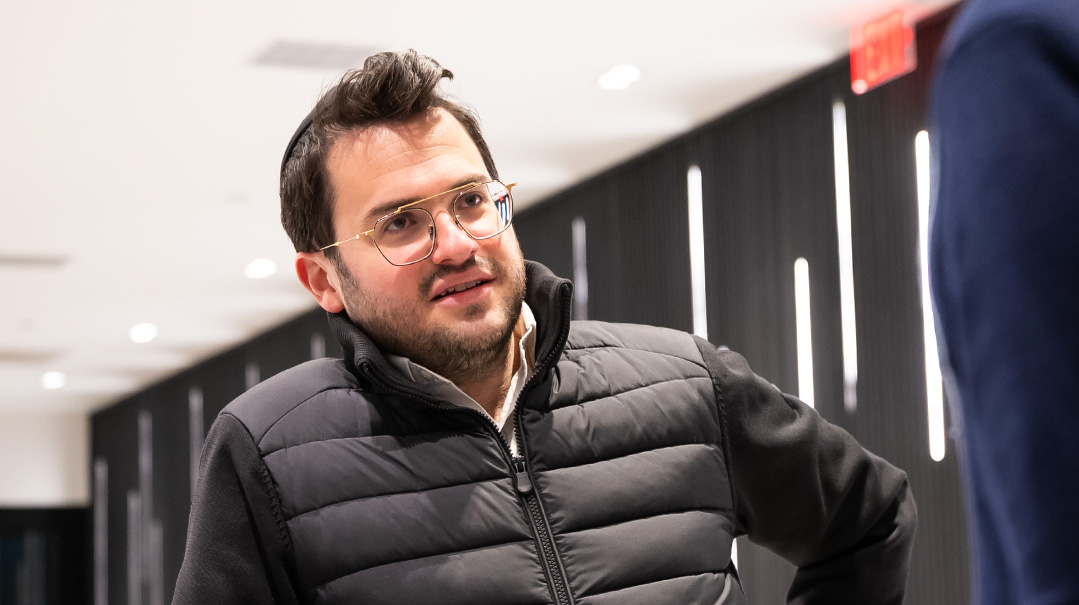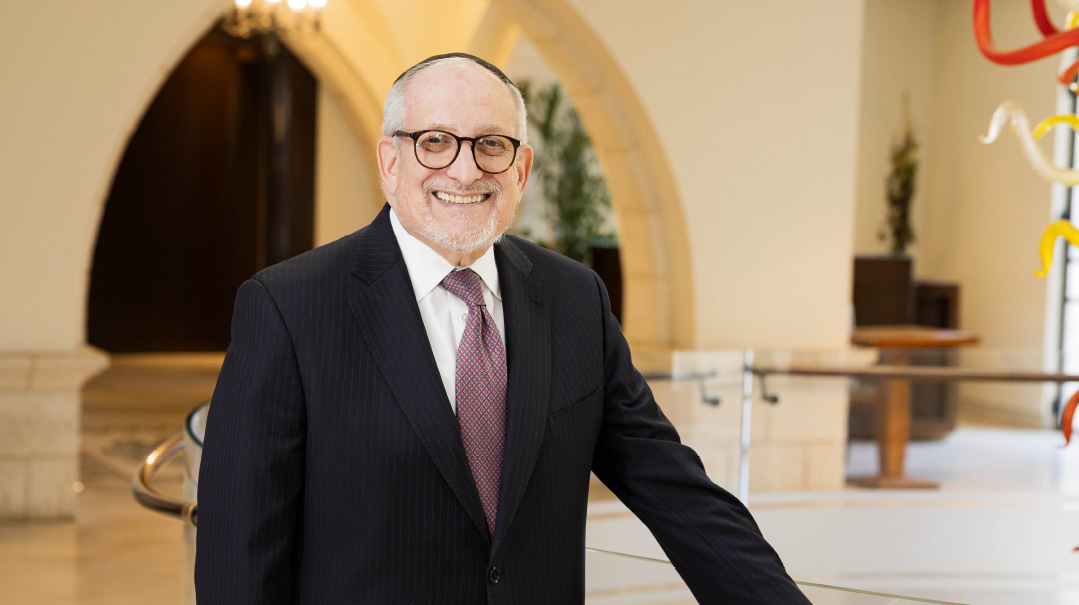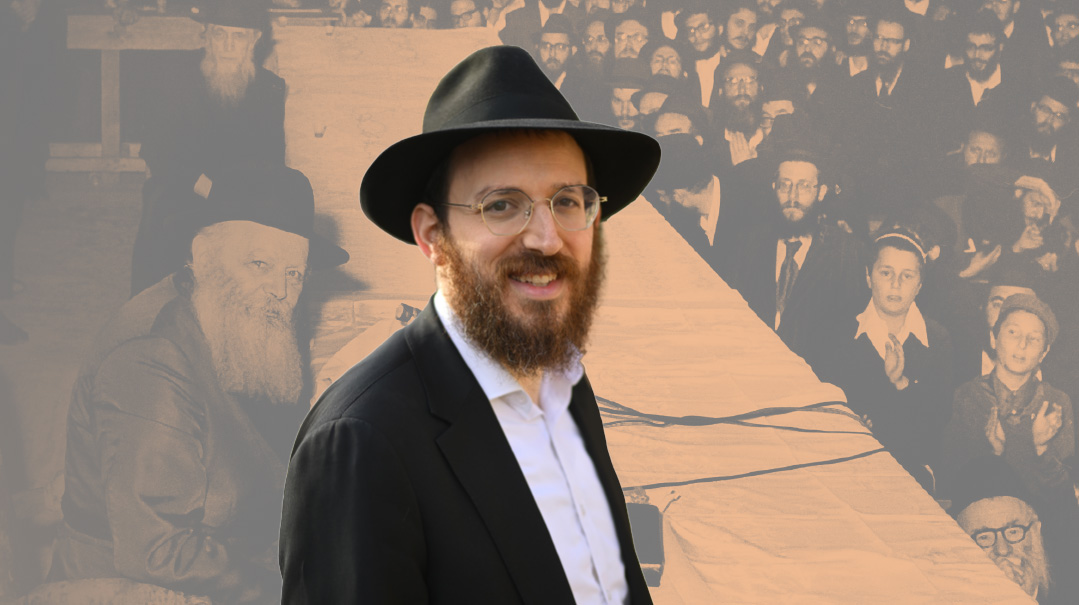My Rebbe, My Rebbi
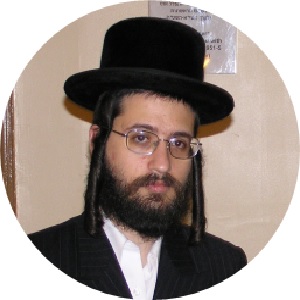
The Bobov-45 Rebbe gifts his kehillah the crown of Torah
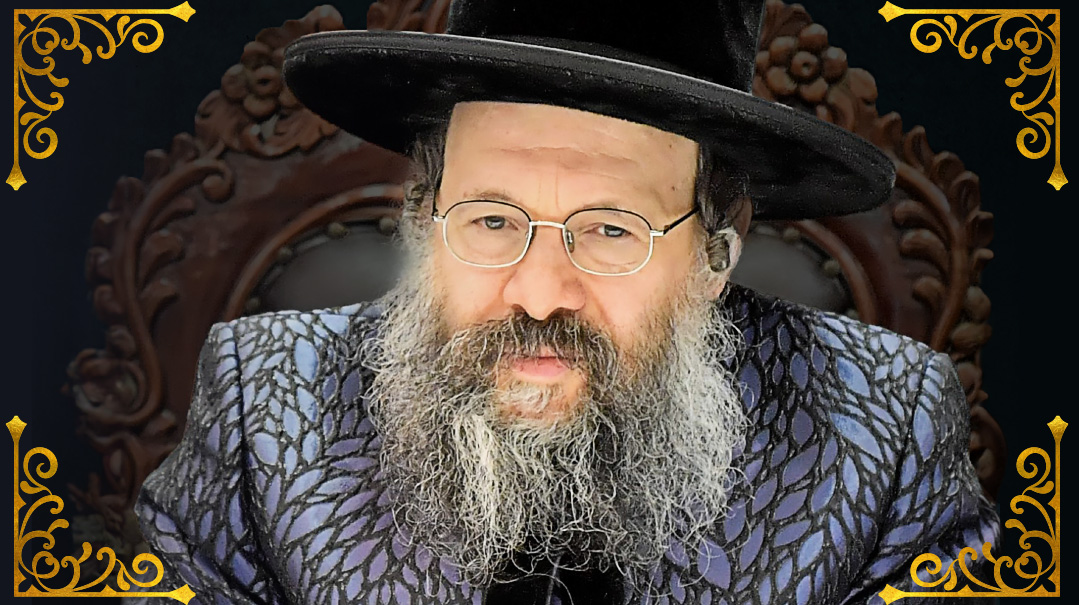
Photos: Mareches Beis Tzadikim, JDN
The chassidim of Rav Mordechai Dovid Unger knew their new rebbe was a gaon and tzaddik with the entire Torah at his fingertips. But he also became a pillar of support for his community and beyond, urging them to detach from worthless materialism and to focus on bringing nachas ruach to the holy rebbes who preceded him. Eighteen years in, as Bobov-45 is flourishing, the Rebbe is a fount of inspiration for his own kehillah, and for all those facing today’s grueling challenges
It’s Friday night in Boro Park, and on the second floor of a corner building on 45th Street and 15th Avenue, over a hundred bochurim are gathered as they listen to the man sitting at the head of the table, speaking from the depths of his compassionate, fatherly heart — a star mechanech who has boundless love for his students:
“V’achaltem lachmechem lasova… lachmechem, your bread, is Torah. If you eat your bread to satiation, if you invest yourselves entirely in the Torah hakedoshah, in the morning with a shiur iyun, in the afternoon with a shiur bekius, in the evening with halachah, mussar, and chassidus, and every spare minute in between is spent learning — then ‘v’yeshavtem lavetach b’artzechem.’ You won’t need to worry about the nisyonos of the earthy, material nature that is ingrained in each person. It won’t disturb your avodas Hashem.”
These moments were the peak of my visit to the Bobov-45 empire, my shtreimel concealed behind the tight rows of chassidic bochurim with their “shich un zocken” and “fertel shich” (their knee socks worn with chassidic “quarter” shoes, a slip-on with a low front), a window into one of the most modest chassidic courts.
Those moments illustrated for me, more than any abstract description, the unique figure of their leader, the Bobov-45 Rebbe. Far beyond his astonishing success in establishing an empire of Torah and chassidus that has thousands of followers is his extraordinary ability to fuse his many roles. From being a leader of chassidim who adhere to his every word to the compassionate father figure whose heart is open to the chassidim nonstop; from the lofty figure to whom the chassidim are bound to the ascetic oved Hashem who detaches himself from materialism; from the gaon who has all of Torah at his fingertips to the venerated maggid shiur who dances with joy at another chiddush.
The latter is the position he served in for most of his years, long before anyone could fathom that the young gaon and masmid whose world was centered around Torah and avodas Hashem would become one of the leading rebbes in the chassidic world.
I have long been curious about this court, which doesn’t even have a beis medrash of its own, but whose thousands of chassidim live in the New York area and its environs, and which has branches throughout Eretz Yisrael and Europe.
“You don’t have a chance,” said Reb Berel, a Bobover yungerman who was my address for any possible news from the chassidus. “The Rebbe won’t cooperate,” he declared with certainty.
The chassidim also wouldn’t like the idea — why did they need any publicity?
Yet only a few hours later, I found myself sitting in the dining room of Reb Avraham Chaim, Reb Berel’s father, who would be my Shabbos host. He is a Bobover talmid from the days of Rebbe Shlomo of Bobov, and was one of the close confidants of his son, Rav Naftoli Tzvi. Today, he’s an ardent chassid of the Bobov-45 Rebbe. (Reb Avraham Chaim was a long-time melamed in the Bobover cheder, and when he moved to the new court, he became a melamed in the new mosdos.)
In order to understand the new court, perhaps a bit of history is in order: The first Rebbe Shlomo of Bobov was the beloved grandson of the Divrei Chaim of Sanz, who was succeeded by his son, Rav Bentzion Hy”d, was known as the Kedushas Tzion for his sefer, which was published after he was killed at the hands of the Nazis. Under the Kedushas Tzion, the prewar Bobover court grew briskly and took root throughout Galicia. The Rebbe himself led Yeshivas Eitz Chaim, which produced countless talmidei chachamim and bnei aliyah. Bobov was a vibrant center of Torah and chassidus, as well as the home of prolific chassidic compositions. The Rebbe composed more than a hundred niggunim in his lifetime.
The Kedushas Tzion’s son, Rebbe Shlomo, survived the Holocaust, miraculously spared together with his young son, Naftoli Tzvi, while his wife and other children perished. While Naftoli Tzvi traveled to Eretz Yisrael to learn under the sages of Jerusalem for several years, Rebbe Shlomo settled in America, where he resurrected the ruins of his father’s court, gathering the remnants from here and there, and infused them with a new spirit of Torah and chassidus. With his combination of sweetness, endless patience, and iron will, he was able to draw them into the warm embrace of Bobover chassidus.
The beginning was hard, in a small shtibel on Manhattan’s West Side and then in Crown Heights, but from there, with tremendous mesirus nefesh, he established a chassidic center in Boro Park that spread to every Jewish locale in the world. His chassidim cleaved to this rebbe who built up chassidus on American shores out of the ashes, who exuded wisdom, brilliance, hadras panim, and an open heart to anyone in pain or distress.
Throughout that time, for decades, his son Rav Naftoli Tzvi (“Reb Naftulche”) was at his side. He was the one who helped establish the mosdos. He took upon himself colossal debts to help ease the burden for his father as he reestablished Bobov. At the same time, he was the first to get involved in any charitable cause that was presented to him; he was a well-known figure in the medical community, consulting with doctors if it could help another Yid, and he was even a familiar face in the halls of power, using his influence if it could help bail out a fellow Jew in trouble. In fact, he was late for his own first grandchild’s wedding — and when his father, Rebbe Shlomo, gave him a raised eyebrow over keeping the huge crowds waiting, someone revealed the truth: A fellow was in legal trouble, and Rav Naftoli Tzvi, in emergency mode, jumped on a plane to Washington to speak to a senator on the man’s behalf. Rabbi Moshe Sherer was a frequent visitor, the two often consulting on vital communal issues. Reb Naftulche, always out for the good of the public, also gave his famed haskamah on the ArtScroll Gemara.
Rav Naftoli Tzvi tried valiantly to conceal his greatness, his holiness, and prishus behind a mantel of simplicity. Only after his father, the Rebbe, passed away on Rosh Chodesh Av 5760 (2000), was he no longer able to conceal himself. Chassidim around the world began to speak of the open mofsim that were attributed to the new Rebbe.
Yet he was always health-challenged. Tzaddikim would say that he took the tzaros of Klal Yisrael upon himself in the most literal sense. When he passed away on 12 Adar II 5765 (2005) and his tzava’ah was read in public, his modesty took on an even greater significance. The will was short and mostly included a warning not to write any words of praise on his tziyun and not to build any buildings in his name.
As in his life, so too, in his death. To this day, his tziyun is a place where yeshuos are effected beyond the derech hateva, for both individuals and the klal. On Lag B’omer, thousands stream to his gravesite and see wondrous salvations, following a cryptic statement he once said of himself, “Rabi Shimon will be by me on Lag B’omer.”

As a young avreich, Rav Mordechai Dovid Unger was bound heart and soul to his grandfather, Rebbe Shlomo ztz”l
When Rav Naftoli Tzvi passed away, the chassidus split in a dramatic development that made waves throughout the chassidic world. Many of the chassidim crowned Rav Ben Tzion Aryeh Leibush, Rav Naftoli Tzvi’s half-brother — Rebbe Shlomo’s younger son from his second marriage — as Rebbe, while other crowds coronated Rav Naftoli Tzvi’s second son-in-law, Rav Mordechai Dovid Unger.
Until then, Rav Unger, an ardent Bobover chassid since childhood, had served as a maggid shiur in the mesivta of the chassidus, but not only. He’s hugely respected in the litvish yeshivah world as well, and is often invited to yeshivos such as Telz, Lakewood, Manchester, and yeshivos in Eretz Yisrael to give shiurim. He was especially close with Rav Chaim Kanievsky, who would relish their deep Torah conversations, referring to him as, “the Rebbe talmid chacham.”
He is the son of Rebbe Yaakov Yitzchok of Dombrova, a direct descendant of Rav Moshe’le Unger, who was the son of Reb Mordche Dovid of Dombrova and the son-in-law of the Divrei Chaim of Sanz. With the Rebbe’s phenomenal memory, he can quote entire passages that he heard back in the days in Crown Heights from Rebbe Shlomo, who already then loved him very much.
Already as a child, he was known for his righteousness and avodas Hashem — and mostly for his tremendous hasmadah.
“Everything the Rebbe speaks about today, every madreigah, every bechinah in avodas Hashem — he is there, he has achieved it,” says Rabbi Itche Reinhold, one of the elder chassidim, who remembers the Rebbe as a bochur. “He was an oved Hashem with his entire being, and on very lofty levels.”
“His father, the Dombrova Rebbe, would ask me on the last day of summer vacation, ‘Please, take my son Mordechai Duvid for a short trip. Since we got here to the country, he hasn’t moved away from his Gemara,” says Rabbi Asher Zelig Goldman, who’s joined our conversation. “Of course, I was able to, but only after I promised him that we’d talk in learning the whole time.”
In time, when Rav Unger became Rebbe, Rabbi Yona Halpert, a prominent Satmar chassid, would tell the Bobover chassidim: “Already then, as a boy, when I heard his birchos haTorah every day in the corner of the beis medrash, I knew that he’d grow up to be a great rebbe.”
“As children, each one of us wanted to sleep in the dining room,” one of the Rebbe’s sons recalls, “because we knew that our father was there all the time. When we went to sleep, he was sitting and learning there, and when we got up, he was again sitting and learning. Often, we would find him on Sunday morning seated over the Gemara, still wearing his Shabbos clothes.”
Until a few years before he became Rebbe, the Ungers, a family of 11, lived in a two-bedroom apartment. Parnassah was very tight, and yet he was still thrilled that he had been able to utilize every minute to learn.
From the day he was taken as a son-in-law of Rav Naftoli Tzvi, he became bound heart and soul to his grandfather Rebbe Shlomo, constantly remaining at his side and never missing a chance to hear Rebbe Shlomo’s divrei Torah and wisdom. When the Rebbe looked for someone to reorganize and reprint the teshuvos of the Divrei Chaim, he assigned his grandson to the complex task. There are few Yidden, if any, in this generation who know all the Divrei Chaim’s teshuvos by heart — and the Bobov-45 Rebbe is one of them.
The chassidim love to quote the words that Rebbe Shlomo said during the sheva brachos for his grandson, the future Rebbe. Rebbe Shlomo spoke then about the miracles that he’d experienced when the Nazis tried to kill him and his son Rav Naftoli Tzvi. He said emotionally, “Why did this miracle happen? Why didn’t they shoot us? Because Mordechai Duvid’l needed a father-in-law.” He spoke about the chassan’s roots and the continuity of the generations, which, according to the chassidim, alluded to what would happen in the future.
“When the split occurred and I suggested that we rent the Bais Yaakov hall,” Rabbi Wolf Reichberg shares, “some people laughed at me — how would we fill it up? During those complicated days for the chassidim, the Rebbe himself remained engrossed in his holy tomes. In the end, during the Purim tish, when the Rebbe was officially appointed, it turned out that the hall was packed with hundreds of chassidim.”
Reb Wolf, who was close to each of the rebbes over the past 60 years, was one of the strongest forces behind the Rebbe’s coronation.
When Rav Mordechai Dovid’s chassidim split off from the big beis medrash, they were also excluded from the other mosdos. After a long din Torah, it was ruled that the Rebbe’s chassidim would continue to use the name Bobov in all its official publications and documents, with the addition of “45” (the street of the Bais Yaakov where the tefillos and tishen were held) in order to differentiate between the two courts. (The big Bobover beis medrash is three blocks down, on the corner of 15th Avenue and 48th Street.)
It wasn’t an easy time for the chassidim. The separation was challenging, as was the court ruling that didn’t leave them with any assets. But the Rebbe was there throughout the difficult moments, always with restraint, yishuv hadaas, and with every step conditional on “what does Hashem want from me now.” Right after the ruling was announced, the Rebbe gathered his chassidim for words of chizuk. He urged them to forget the past, to act in ways of peace and conciliation, and to focus on positive action to bring nachas ruach to the holy rebbes who preceded him.

The Rebbe was especially close with Rav Chaim Kanievsky, who would relish their deep Torah conversations and would refer to him as “the Rebbe talmid chacham”
It’s getting late, and we hurry so that I’ll be able to witness the “tallis leigen.” This is a custom I’ve never seen, but in Bobov, the custom is that the Rebbe puts on his tallis in public as the chassidim sing quietly. Before that, he tastes a bit of the Shabbos fish, and learns from the sefer Noam Elimelech wherever the sefer opens to. On the first Shabbos of the Rebbe’s leadership, the elder chassidim presented him with a new tallis.
For the chassidim, Shabbos has begun, but those in the Rebbe’s inner circle say that for him, Shabbos actually begins to percolate on Thursday, and sometimes even on Wednesday. In contrast to the other days of the week, the Rebbe doesn’t receive the public on Friday, because the next day is already Shabbos. One family member told me, “When someone comes to be mazkir for a yeshuah on Thursday, the Rebbe says, ‘Oh, it’s almost Shabbos, ‘Shabbos hi milizok u’refuah kerovah lavo.’ And sometimes, already on Wednesday the Rebbe will say, ‘Oh, today we already said Lechu neranenah in shir shel yom, we’re getting close to Shabbos, so the zechus of Shabbos will surely protect.”
Friday night. The temporary beis medrash in the Bais Yaakov on the corner of 45th Street is packed. The walls are filled with signs about the new Bobover community in Union, New Jersey, and notices about upcoming fundraising events for the mosdos.
For the past 18 years, the Bais Yaakov girls’ school undergoes a transformation on Friday. A group of workers comes in and arranges the tables, sets up the bleachers, prepares the place for davening. On Motzaei Shabbos, right after Melaveh Malkah with the Rebbe, the work team will turn it back over into a school lunchroom for the coming week. In recent years it’s gotten very tight, but the good news for the chassidim is that the kehillah will soon be moving into a huge new shul on 49th street and 14th Avenue.
I’m fast-forwarding here to Sunday morning, when I get to see this project in person, accompanied by project manager Rabbi Usher Yaakov Brunner. What looks on the outside like another local construction site turns out on the inside to be one of New York’s architectural wonders. It’s a massive place, a full square block, with many galleries and sub-divisions. The basement level will be a huge Torah center, and in the level below that, a spacious, well-appointed mikveh is being constructed.
The structure currently under construction is less than half of its future size. Later, the building next door will be demolished, and the shul will be expanded to nearly 200,000 square feet, spanning the entire block. Meanwhile, the chassidim hope to move in for the Yamim Noraim, and are counting on the well-known Belzer architect, Rabbi Aharon Ostreicher, who is overseeing the project.
For a relatively new kehillah, Bobov-45 has seen unusual success in the building of its new mosdos — there hasn’t been a kehillah that has raised and built so much in such a short time. The Rebbe is currently shouldering projects of over $170 million; these include a new Talmud Torah, mesivta and mechinah buildings, several new buildings in Union, New Jersey, where many young families have moved, and the massive Boro Park shul, which when completed will be the largest in New York City.
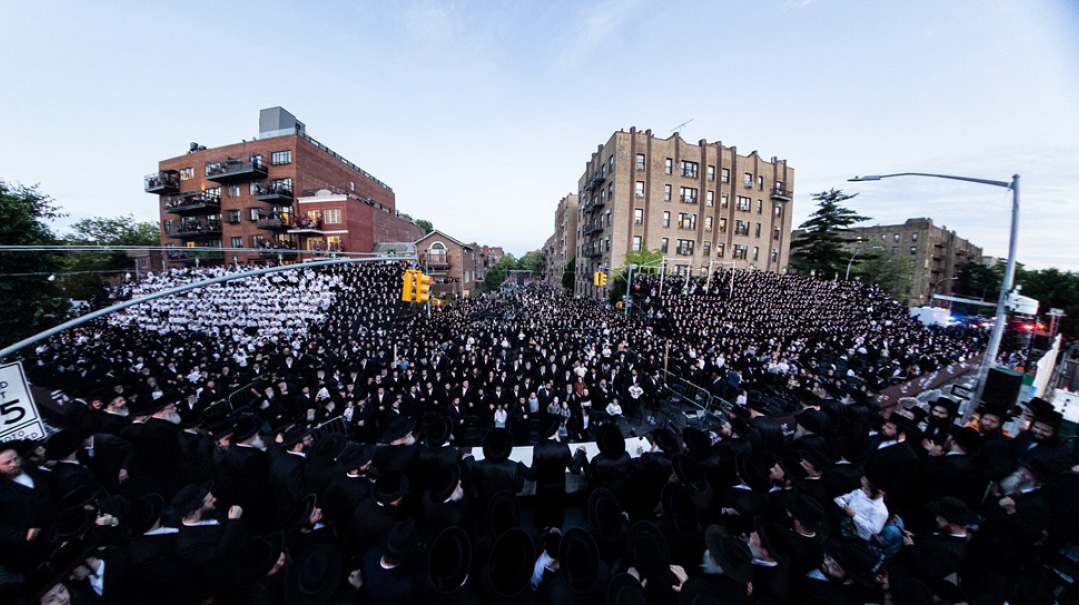
The cornerstone ceremony for the new beis medrash was proof for all those who thought there wouldn’t be a crowd
Back to Friday night: I take a place from where I can see the Rebbe close up. Behind me and in front of me, there are many elderly chassidim. In the middle of Kabbalas Shabbos I recognize the Yid sitting in front of me as philanthropist Reb Binyamin (Ben) Barber of the textile industry, who sat and swayed like an ardent chassid in front of his Rebbe. At the end of davening, the crowd passes by the Rebbe, who warmly wishes each one Gut Shabbos. It’s interesting, because the Rebbe doesn’t speak that much, he’s not effusive with compliments, and generally weighs every word. I offer my hand in greeting, and I give the Rebbe warm regards from the shtibel of the chassidus in Antwerp, where I live. The Rebbe doesn’t respond, but nods his head in satisfaction.
I go home with my host for the seudah, Reb Yaakov Elbaum, a friendly yungerman surrounded by adorable children. I would have stayed there longer, if not for the fact that one of the family members whispered to me: “You’d be wise to hurry a bit, so that you can take a peek into the bochurim tish.” I learn that the Rebbe adopted a practice on the late summer Friday nights to make Kiddush with the bochurim, with a different age group in attendance each week, and to eat the first part of the seudah with them. He comes out to the main tish only for the second part of the meal.
I hurry to the shul, go up to the second floor, and without asking, I slip into the seudah that’s generally closed off to married men. I stand behind the bochurim and watch, riveted, as the Rebbe sits at the head of the table, alongside some of his grandsons, surrounded by a group of bochurim. At that moment, it’s just the Rebbe and them. He asks them to sing, and he lets them serve him — none of the regular gabbaim are here. He delivers divrei Torah, with mussar, pilpul and drush — and all with his signature clarity.
The bochurim see the Rebbe’s ahavas Torah firsthand. Even after he became Rebbe, he didn’t give up the pleasure of teaching the young talmidim. The Rebbe still carries the title of Rosh Yeshivah, and as such, he comes to the yeshivah at least twice a week to give a long iyun shiur. That’s the Rebbe’s greatest pleasure, and he won’t give it up, no matter what.
“The Rebbe knows each bochur by first name,” says one of the boys, Herschel Miller, who also writes down the Rebbe’s Torah from the Shabbos meals for the bochurim.
The Rebbe prepares his regular shiurim with his son, Rav Chaim Bentzion, who serves as a maggid shiur in the yeshivah.
“If the Rebbe is traveling, he’ll take sifrei iyun with him to prepare the shiur,” one of the confidants tells me. “If the Rebbe is not in town, he’ll give the shiur by phone.”
The Rebbe, the chassidim explain, considers it a holy obligation to delve into the Torah of his ancestors, among them the Baruch Ta’am, the father-in-law of the Divrei Chaim, as well as Rav Shmuel Engel, the Shoel U’meishiv, Rav Shlomo Kluger, the Kol Aryeh, and others. That’s aside from the Divrei Chaim, whom the Rebbe feels a strong emotional connection with. There isn’t a shiur when the Rebbe doesn’t delve into a deep piece of the Divrei Chaim. It’s as if the Rebbe “lives” his zeide all the time.
“Once, during a visit to Eretz Yisrael,” one person tells me, “the Rebbe met a Yid who was working to clarify the Torah of the Baruch Ta’am.
“ ‘Why don’t you publish your work?’ the Rebbe asked him.
“ ‘I don’t have money,’ the man replied.
“ ‘I’ll give you $5,000,’ the Rebbe said, and asked the gabbai to write out the check.”
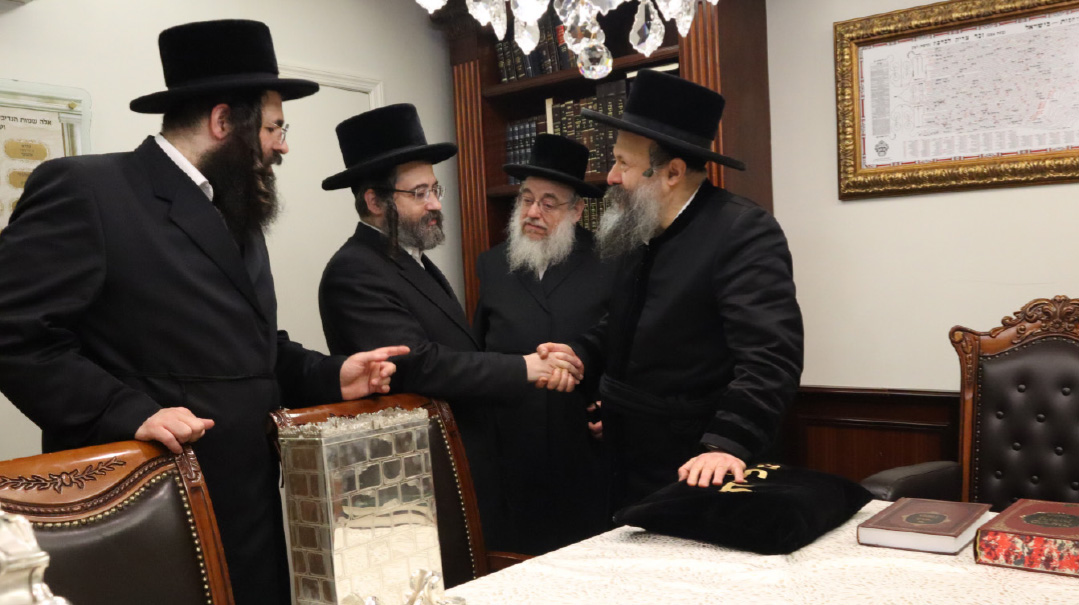
Mishpacha’s David Damen with the Rebbe: “We need to show the young people that the Torah is sweeter than honey”
Downstairs, in the big hall, the chassidim are already waiting for the second part of the tish. The Rebbe takes a seat at the table. Alongside him is his brother-in-law, Rav Yehoshua Rubin, a respected and influential av beis din in New York who served as the rav of the chassidus, and with whom the Rebbe has an extremely warm relationship.
The Rebbe sends shirayim mostly to the elder chassidim, and to guests. When he notices a new guest, he finds out his name from the gabbai, Rav Chaim Yona Weiss, and then sends the guest a large amount of shirayim. So I find myself hearing my name being called — and they send me a full plate of sweet cooked carrots. I’m just afraid that someone might reveal to the Rebbe the real reason this guest is here….
Now their singing, this time with a niggun that the Rebbe composed to the words of “Yom Menuchah U’kedushah.” What does the Rebbe have with composing niggunim? I ask one of those in the know. He tells me the first niggun the Rebbe composed was while he was learning Gemara. He felt that the song had been sent to him from Above, to help infuse a love of Torah. The Rebbe once remarked that the niggunim he composes are sent to him from Above, to show him that just like he doesn’t know how to compose and it’s all from Above, likewise, all his other talents — they are all a complete gift from Above. Since then, the Rebbe has composed some nine songs. Some of them are very joyous ones, especially those that he composed when Covid pandemic faded away.
The Rebbe always has a happy demeanor, and this time is no exception. Not a pulsating, over-cheerful type of joy, but rather a more contained elation that is manifested by an expression of internal tranquility. When the Rebbe once visited Rav Wosner, the Rav told him, “I see upon you a rare simchah, a simchah that stems from Torah and tefillah.”
When the clock shows 2:30, I find myself dancing with the chassidim to “Tnu Shevach,” my hands on the shoulders of the man in front of me, and he in front of him, and so forth, and the Rebbe leads the whole procession in the circular dancing all around the hall.
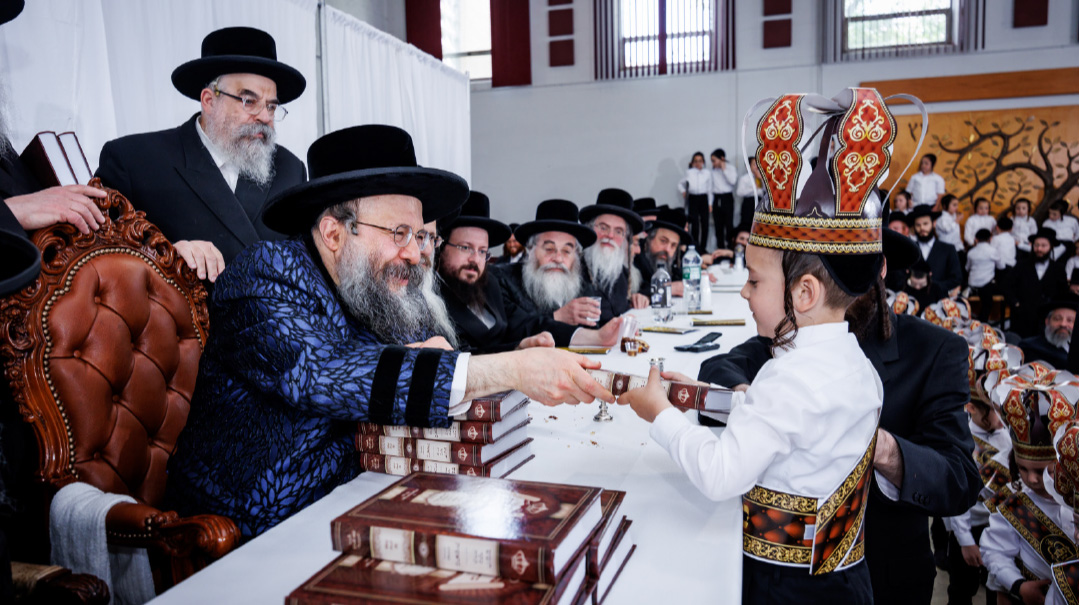
Mishpacha’s David Damen with the Rebbe: “We need to show the young people that the Torah is sweeter than honey”
I eat the morning seudah at the home of my friend Reb Berel, who works tirelessly on behalf of Bobov-45. Toward the end of the meal, his friends Reb Avrohom and Reb Moshe Yitzchak come to visit. They share many personal stories, which I learn is standard — it’s the personal connection the Rebbe has with every chassid, the endless worry that he carries in his heart for every chassid.
Reb Avrohom tells me about an orphaned relative, a bochur, whom the Rebbe called on Erev Rosh Hashanah and presented with a sefer with a personal inscription. The Rebbe then promised the boy that he would daven for him over the holy days. Another time before Shevii shel Pesach, the Rebbe called this bochur to his room and learned with him for two hours. Another time, the Rebbe called him and whispered, “I noticed you got new shoes, but from what I can see they’re not so comfortable. I think you need an insole, and I can tell you where to buy it.”
Reb Avrohom tears up as he relates how he’s dealing with the challenge of a daughter who was badly burned and is undergoing very difficult treatments.
“When it happened, I called the Rebbe from the hospital, and he gave me a brachah and promised that he would wait up for me until I came home. When I came back, I went to the Rebbe’s house — it was after two in the morning, and the Rebbe opened the door and wanted to hear every detail.”
Reb Moshe Yitzchak relates how, as an orphan, the Rebbe would call him and ask him to bring his tests every two weeks so he could check them. “That was a tremendous incentive for me to do well on those tests,” he said.
Before his wedding, the Rebbe summoned him to his room, went over to the shelf and took out a whole binder with all his tests — a gift for the chassan.
I kept hearing this theme — the Rebbe as a compassionate father. A rebbe who not only listens, but also is able to enter the broken heart of the person in front of him and turns over the world to help him. The Rebbe will not rest until he helps a Yid, even if that person is not a Bobover chassid, and sometimes, without anyone in the world knowing about it.
One chassid tells me: “I had a business partner, and the conflicts that arose left me with no choice but to dissolve our partnership. I was very confused and really shattered. I came to the Rebbe, and he sat with me for two hours, until the middle of the night, and together, we made the calculations and he guided me exactly what to do, as if he were an experienced businessman.”
Another chassid reveals to me what many of the chassidim don’t even know: One Pesach, the Rebbe left secretly before the Seder and went to a distant hospital to visit a Jew who was in serious condition. And not long ago, the Rebbe accompanied a Yid to see a therapist.
One of the Rebbe’s sons related how he brought a young man in a serious situation to see the Rebbe. The man poured his heart out to the Rebbe, but the Rebbe just sat and listened, with no visible reaction, just a brachah and lots of encouragement.
After escorting his guest out, the Rebbe’s son came back to the room and found his father weeping. The Rebbe explained: “I felt that he needed a sense of stability and clarity. If I had cried in front of him, he would have left shattered, with an even more broken heart. I had to hold myself back so that I wouldn’t break his spirit.”
One of the prominent chassidim tells me about a moving incident that sheds light on how the Rebbe looks for every way possible, no matter how original, to ease another’s suffering: “Rabbi Berish Freilich, a well-known senior askan, once came to the Rebbe in order to help out one of the chassidim in a difficult situation. He sat in the room together with the Rebbe and waited for this person, who was a bit late. When the chassid entered the room, the Rebbe said, ‘Let’s stand up for him,’ and, taking Reb Berish’s hand, together they stood up in honor of the brokenhearted chassid. This exceptional step gave him indescribable strength.”
The phone doesn’t stop ringing. People call to be mazkir, to ask questions, and the Rebbe tries to answer every person — but always in his measured way, and always after deep, comprehensive thought. Meanwhile, the Rebbe hardly rests. His nights are getting shorter. Almost daily, he’ll call a doctor or askan himself to try and help another Yid. Over time, the Rebbe has become an address not only for Bobover chassidim, but for many Yidden who seek him out.
But the Rebbe doesn’t only give; he also has extensive spiritual demands of his chassidim. He wants them to disconnect from the trivialities of this world, to distance themselves from the temptations of our times. The Rebbe himself has given up a lot of money when it was conditioned on certain compromises in chinuch.
The Shabbos passes quickly, and for me, it’s been a fascinating glimpse into some special minhagim. The singing, the short peiros tish in the summer, during which the Rebbe sings special piyutim for every Shabbos between Pesach and Shavuos. I also take in the Rebbe’s divrei Torah. He is like an endlessly bubbling fountain — vort after vort, chiddush after chiddush.

The new beis medrash, covering an entire block. For a relatively new kehillah, Bobov-45 has seen unusual success in the building of its new mosdos
Eighteen years have passed since the Rebbe was appointed, and the chassidus has become a veritable empire. It numbers thousands of chassidim and new mosdos both in America and around the world. Nearly 4,000 students attend the mosdos today in Boro Park alone.
“Everything you see here is a combination of lots of good things, but what connects all this historic success is the enthusiasm of the chassidim and their love for the Rebbe,” says Rabbi Yaakov Yosef Steinmetz, the venerated executive director of the mosdos.
Rabbi Steinmetz is actually a Skverer chassid whom the Rebbe picked out to run the mosdos and to help them grow to where they are today. Within the court, the Rebbe has established a series of organizations for Torah and chesed, plus an organization for yungeleit.
The Rosh Hakahal, Rabbi Isaac Deutsch, was the entrepreneur who jumped in from the first day with sheer grit and dedication in order to establish and build what has turned into a massive empire.
But it wasn’t always like that, the insiders say. On the contrary. The challenges that the new court went through were both many and difficult. The biggest blow came the day after Purim 5768 (2008), when Bentzion Dunner, the main supporter of the chassidus and relative of the Rebbe, perished in a tragic accident. The chassidim describe what followed.
“It looked like everything was crumbling in front of our eyes,” they recall. “They were at risk of losing the down payment he had made to purchase the girls’ school, together with the whole building. A period of severe austerity followed. The money stopped coming, salaries weren’t paid for months, and the situation looked dismal. One of those Fridays, the Rebbe took dramatic action. He asked to hang a note, in his handwriting, stating, among other things, the following regarding the klei kodesh waiting for their salaries: ‘Their peace of mind is our peace of mind, their worries are our worries. In recent weeks, I have been working day and night, and feel that this is my personal responsibility, and I am sure that b’ezras Hashem we will succeed.’
“This is how the Rebbe gave us chizuk again and again,” says Reb Wolf Reichberg. “Whenever something challenging arose, the Rebbe gathered us together and infused us with the calm and his emunah that everything would work out. He took personal responsibility for every step, and we would leave those meetings, perhaps without money, but feeling stronger.”
The mosdos are still supported by the dedication of the chassidim, who stretch themselves. Ever so quietly, however, a few young gvirim have come onto the scene and are pumping in huge contributions to help complete the ongoing projects.
AS my visit winds down, I’m both excited and tense about what’s coming next: my personal audience with the Rebbe. I don’t know what to expect, but I’m a bit nervous that I’ll get a dressing-down for my invasion of the chassidus’s private territory. I wait in the anteroom, and when I’m called inside, my heart is pounding.
The Rebbe stands near his table, wearing his regal garb, leaning on his silver cane. When he sees me, he remarks jokingly, “I didn’t know until now that there was a ‘spy’ among us all Shabbos….”
Realizing my secret is out, I answer meekly: “Perhaps, but I’m the type of spy that is looking for only good things….”
The Rebbe asks what I do, and I tell him about my different writing endeavors. “I try to disseminate things that are positive and beneficial, and to make the world a better place,” I say.
I tell the Rebbe that I was coming from a visit to the shul that is under construction, and I note that when I was a young boy and they laid the cornerstone of the big building in Belz, the world laughed at us. They didn’t understand why we needed such a large beis medrash. Today, when there isn’t room for a pin, no one is asking those questions anymore.
I tell him about my family’s roots in Dzikov, and the Rebbe speaks about the Dzikov angle of the chassidus. As is known, the first rebbe of the dynasty was the son-in-law of Rav Eliezer of Dzikov, the son of Rav Naftali of Ropschitz.
How much of an influence did Dzikov have on Bobov? I ask.
The Rebbe smiles at the question and quotes the words that Rebbe Shlomo once said: “Bobov is a wonderful combination of Sanz and Dzikov, the brilliance of Sanz and the pleasantness of Dzikov. Of course, the rebbes of Dzikov were also geonim in both nigleh and nistar.”
He then clarifies: “The minhagim were from Sanz. We didn’t alter them, but the customs of Dzikov came as an addition, not to detract from the Sanzer customs. The songs you heard us singing at the peiros tish are a Dzikover custom.”
I then ask the Rebbe respectfully, “The Rebbe speaks a lot about Torah, but why is it that specifically in our generation, when there is so much Torah, we don’t have the gedolei Torah of previous times?”
The Rebbe nods in agreement, thinks a bit, as he always does before an answer, and then says: “Some say that the quality of the previous generations has been replaced by the quantity of learners. In other words, in every generation, there is a hashpa’ah of Torah, but in previous generations, this influence was concentrated among a few people, while the rest were simple people who didn’t know how to learn, and therefore the Torah of those who did learn was of higher quality. In our generation, the abundance of Torah learning has spread over everyone, and there isn’t a Yid that isn’t connected to Torah, but at the same time, the quality has diminished.”
“The Rebbe speaks a lot about ahavas Torah,” I add somewhat doggedly. “How can we really endear the Torah to the young people in a generation so full of temptations?”
The Rebbe’s face grows serious and he answers: “The way to do it is very simple, and it has never changed. We need to show the young people that Torah is sweeter than honey. And for those older, we need to convince them to just try it out and give it a chance. But we know one thing, that we as parents and mechanchim have nothing to do but raise our hands to daven, and daven, and daven endlessly to Hashem from the depths of our hearts to save us.”
The gabbai, Reb Chaim Yona, is already standing with the Rebbe’s overcoat; he’s impatient, seeing that the conversation lasted longer than is generally accepted. I mention a few personal matters and the Rebbe gives me a brachah and takes leave with a smile.
Outside, the young chassidim are waiting for us. Of course, they want to hear every word that the Rebbe said. Leaving Brooklyn, I visit Union, the first Bobov-45 town established outside Boro Park.
“It’s not simple at all,” Rabbi Yosef Knopfler, the head curator of the Machon Mareches Beis Tzadikim archives and publisher of all Bobover seforim, tells me. “The Rebbe didn’t want yungeleit to move to new places that are not closely under the supervision of gedolim, yet on the other hand, not everyone can afford to stay in Boro Park. But after years of searching and thorough preparation, the Rebbe agreed that we should settle here.”
Union is young and vibrant, second only to the nearby Jewish settlement of Linden, which is bigger. While the Rebbe appointed his oldest son-in-law, Rav Chaim Boruch Halberstam, to serve as mara d’asra, people who aren’t Bobover chassidim are also moving to Union and are warmly welcomed.
The town’s success is largely due to the Rebbe’s own forward thinking, having created a professional team to set down all the necessary infrastructure for a heimish community. Over a hundred families are expected to move in by the end of the summer.
The Rebbe doesn’t want the town to be only for his chassidim, but he does want it run according to strict guidelines that he has set. The Rebbe sees this place, which is on the route between Boro Park and Monsey, as a city of the future for the chareidi community seeking affordable housing solutions.
Meanwhile, I think about what Rabbi Wolf Reichberg told me in the anteroom: “Baruch Hashem, we merited a lofty rebbe from a previous generation, who has effected countless mofsim. But the biggest mofeis of all is his army of chassidim, who’ve been imbued with his infinite tranquility, emunah, and bitachon.”
(Originally featured in Mishpacha, Issue 1015)
Oops! We could not locate your form.


